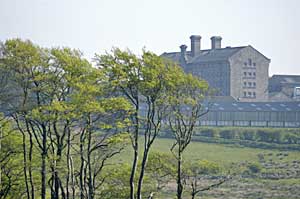|
OBJECTING TO WAR
FIRST CO TO DIE
2 EUROPE GOES TO WAR
3 COUNTDOWN TO CONSCRIPTION
4 FUNDAMENTAL CHANGE IN SOCIETY
5 NO CONSCRIPTION FELLOWSHIP
6 THE SECRET PRESS
7 MANY TRADITIONS
8 THE TRIBUNALS
9 TRANSCRIPS
10 THE 'won't-fight-funks'
11 THE COST OF CONSCIENCE
12 UNWILLING SOLDIERS
13 ALTERNATIVES AND DILEMMAS
14 PRISON
15 THE MEN SENTENCED TO DEATH
16 COERCION FAILS
17 DYCE
18 DARTMOOR
19 THEY WORK IN OVERCOATS
20 THE MEN WHO DIED
21 WINDING DOWN
21 SELECTION OF BOOKS
22 FROM CALL UP TO DISCHARGE
WHY WAR? supplement
|
|
|
|
By late autumn Dyce, was deemed totally unsuitable and abandoned. Men considered to have abused their privileges for trivialities such as being three minutes late for work, or handing out 'peace propaganda' were returned to prison, the others were sent off to make manure from bones and carcasses of animals where the stench was so appalling, and the men, allowed no baths, smelt so disgusting, that no locals would go anywhere near them.
In December, Lloyd George became Prime Minister with a Cabinet that included two of the most passionate champions of compulsory military service. A new Code of Rules for COs with detailed guidelines about hours of work, and pay, and behaviour was drawn up and Dartmoor Prison was taken over; and as a sop to everyone's sensibilities, renamed Princetown Work Centre and locks were removed from the cell doors.
|
|
In the early spring 900 men arrived in groups to begin their work of national importance.
There were some Tolstoyans, a few socialists, a number of Quakers and some anarchists who, on the journey to the prison, told their fellow travellers that they fully intended either to escape or to create havoc. The variety of men, the uneasy mix of their pasts and their beliefs, in the conditions in which they were now put, was enough to make certain that the work centre, like all its predecessors, was doomed.
Here some of the conscientious objectors were put to work inside the walls. The rest were sent out on to the moors, to the farm or to the quarry. They crushed oats on antiquated machinery or carted granite for ten hours a day.
|
|
 Dartmoor Prison had been built at the beginning of the 19th century amid fears of a mutiny or epidemic to house 10,000 French prisoners from the Napoleonic wars, who had been confined in six hulks in Plymouth harbour. The French prisoners built the prison themselves and by 1812 they were joined by Americans. By 1850 the French and the Americans were gone, and the prison reopened as the first British penal settlement to house British convicts, the colonies, apart from Australia, having grown tired of absorbing British criminals. Dartmoor Prison had been built at the beginning of the 19th century amid fears of a mutiny or epidemic to house 10,000 French prisoners from the Napoleonic wars, who had been confined in six hulks in Plymouth harbour. The French prisoners built the prison themselves and by 1812 they were joined by Americans. By 1850 the French and the Americans were gone, and the prison reopened as the first British penal settlement to house British convicts, the colonies, apart from Australia, having grown tired of absorbing British criminals.
|
|
Experience of Dartmoor varied from man to man and from time to time – outside work in the winter was unpleasant and exhausting; work in the hospital wing, on the other hand, some compensation such as a bed with a mattress; most work was, at best, monotonous.
|
|

:: the 'conchie wall' today with the prison in the background.
|
|
Those not exhausted by perpetual manual labour were able to make friends with some of the other conscientious objectors, print news sheets on an old prison hand press and arrange concerts in the enormous prison chapel. It was not a bad life, some remembered; many of the men were very inventive and even constructive, offering to build a church in the village which they duly did, so that to this day Princetown has the only church built by prisoners in Britain.
The ultimate sign of the futility of much of their work is still visible today. A little way up the road from the prison there is a rectangular field, perhaps three or four acres, bordered by a neat, seven-foot-tall drystone wall. The grass inside is green and lush; there are no boulders, no stones, nothing. Some local still know it as 'Conchies' Field' though they know nothing of its origin. Every day men were marched under the eyes of the warders on their ponies, to work on clearing stones and building walls. Nothing was ever done with the field; it was simply designated; cleared, and then left.
|
|
